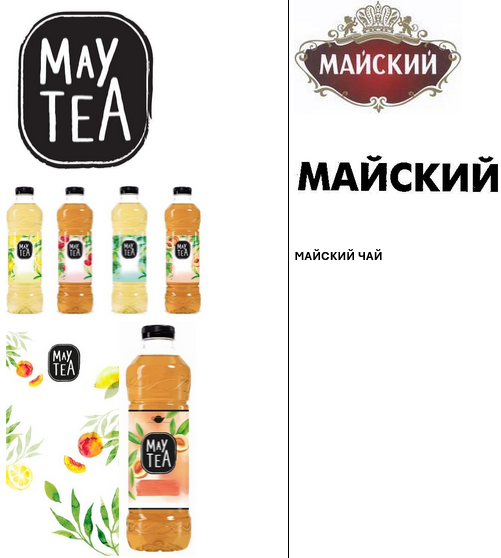Schweppes saves May Tea trademark from Cyrillic challenge

With 24 official languages and three official alphabets, considering linguistic diversity within the EU can be a real headache when assessing the risk of trademark confusion, as Louise Péchoux discusses in the context of the recent ruling on the Schweppes May Tea trademark by the EU General Court.
In its judgment of 25 February 2025, the General Court of the European Union ruled on the possible conceptual comparison between two trademarks from two different languages and alphabets (joined cases T1066/23 to T1069/23).
Background to the case
In 2020, May OOO brought a declaration of invalidity against EU trademarks composed of word elements in English registered in the name of Schweppes International Ltd. on the basis of its earlier trademarks in Russian and Cyrillic (trademarks at issue pictured below). All the marks designate similar goods and, in particular, 'tea' in class 30.

From tea to linguistics
These brands have little in common at first glance. However, if you have a basic knowledge of Russian and English, you might recognise that the terms МАЙСКИЙ ЧАЙ and MAY TEA have the same literal meaning. It is for that reason that May OOO argued that the relevant public – the Latvian consumer with knowledge of both English and Russian (the earlier trademark МАЙСКИЙ ЧАЙ was protected in the Czech Republic, Germany, France, Latvia, Poland and Slovakia) – will directly associate the trademarks.
This analysis was validated by the EUIPO Board of Appeal in 2023, which recognised the conceptual identity, finding a likelihood of confusion and thus, invalidating the Schweppes May Tea trademarks. Although it is not disputed that the consumer will perceive the differences between the signs, the EUIPO Board of Appeal found, in particular, that it is conceivable that the consumer may perceive the contested mark MAY TEA as a variant of the mark МАЙСКИЙ ЧАЙ which has been adapted to all consumers on the entire EU market.
The Tribunal's decision
Although recognising the conceptual identity between the marks, the General Court of the EU, recalled in its ruling that the likelihood of confusion implies an interdependence of all relevant factors. These factors may be: the similarity of the goods covered, the distinctiveness of the signs, the degree of visual, phonetic and conceptual similarity, the reputation of the earlier mark, and so on.
For May OOO, the only criteria supporting its argument were the similarity of the goods designated and the conceptual identity of the signs, while several factors run counter to its argument of the likelihood of confusion, namely:
- A lack of visual similarity, which is a criterion that is all the more important because the act of purchasing tea is essentially based on the visual aspect of the product (special mention here for the figurative elements of the trademarks which are taken into account in the overall analysis of the likelihood of confusion while they were excluded in the comparison of the signs because they lack any distinctive character according to the Court);
- Very low, if any, phonetic similarity (the pronunciation of the mark MAY TEA is 'mei-tii' while that of the mark МАЙСКИЙ ЧАЙ is 'mai-ski-tchai');
- A lack of distinctiveness of the terms 'tea' and 'чай' to designate tea-related goods, which limits conceptual identity in the overall assessment of the likelihood of confusion (whereas it is also recognised that the elements 'may' and 'майский' have a normal distinctiveness).
Taking all these factors into account tipped the Court's balance towards the absence of a likelihood of confusion, therefore, and the annulment of the decisions of the EUIPO Board of Appeal.
Assessing the likelihood of confusion for translated trademarks
This judgment provides me with an opportunity to take stock of the assessment of the likelihood of confusion between two trademarks in different languages, a method recalled and used by the General Court here.
Firstly, the linguistic difference alone is not enough to exclude any existence of a conceptual similarity. To assess this, it must be considered that the average consumer will not make an in-depth analysis of the brands they encounter or a detailed linguistic analysis, particularly for everyday purchases. Consequently, the assessment of the conceptual similarity must be based on the consumer's spontaneous perception.
In this judgment, Schweppes argued that, for the Latvian public, the comparison of the meaning of the marks would be a twofold intellectual effort, the translation of MAY TEA into Latvian and then the translation of МАЙСКИЙ ЧАЙ into Latvian. According to Schweppes, it is unlikely that the consumer will engage in such an analysis when simply buying goods in a supermarket.
However, the Court points out that the consumer may make an immediate conceptual approximation by taking into account:
- (i) the linguistic knowledge of the relevant public and
- (ii) the degree of kinship between the languages concerned and the actual terms used by the signs in question.
The Latvian public has at least a basic knowledge of English and Russian (we note here that the General Court only recognises a basic knowledge of Russian by the Latvian public, whereas it already recognised in Plombir that the knowledge of Russian by the Baltic States is a well-known fact). The terms 'may' and 'tea' in English and the terms 'майский' and 'чай' in Russian are basic concepts of these languages. It is also specified that the term 'may' is close to its Latvian equivalent 'maijā'. The Court concluded that there was an immediate conceptual rapprochement between the marks without a double intellectual effort or complex mental process. Moreover, this spontaneous perception is also made possible because the grammatical structure of the word elements of the marks at issue is identical, an adjective followed by a noun.
Conceptual identity will then not only be a simple translation of a brand, but an instant translation in the consumer's mind. For example, the differences between the signs ROTKÄPPCHEN and RED RIDING HOOD are too great and prevent immediate conceptual approximation (T128/15). While it is indeed a translation, it will not be instantaneous for the consumer (the terms themselves do not a priori belong to the basic vocabulary of German and English and have different structures).
Although conceptual identity is accepted in the May Tea judgment, this is not sufficient to demonstrate a likelihood of confusion between the marks at issue. In reality, this is rarely sufficient for the General Court, which, as we have recalled, attaches paramount importance to the interdependence of all factors. This is also what we learned from the BALLON D'OR/GOLDEN BALLS joined cases (C581/13 P and C582/13 P), in which the Court of Justice of the EU confirmed that a low degree of similarity may be sufficient due to the presence of another relevant factor such as the reputation of the earlier trademark.
In yet another decision, comparable to the May Tea decision, the Court instead recognised the likelihood of confusion between the earlier German trademark B-WOHNEN and the applied-for trademark in English B.HOME. However, the marks are visually and phonetically similar to a low level and only moderately similar conceptually. The distinctiveness of trademarks is also low and the public also has an above-average level of attention ((10 February 2021, T‑821/19, not published)). What seems to have played in favour of the risk of confusion here is the presence, although weak, of visual and phonetic similarity in addition to conceptual.
In comparison with the decision in B-WOHNEN/B.HOME, it is likely that the difference in alphabet played a decisive role in the failure to recognise the likelihood of confusion. We note that the Cyrillic alphabet is an official alphabet of the EU (following Bulgaria's accession to the EU in 2007). The same solution would most likely be adopted for trademarks in Chinese characters, for example (unless perhaps it is a transliteration, which would imply a certain degree of phonetic similarity?).
Key takeaways from the Schweppes May Tea trademark ruling
In finding against May OOO and for Schweppes, the EU General Court is rather reluctant (obviously more so than EUIPO!) to penalise a mark solely on the basis that it is the translation of an earlier mark into another language. This solution is understandable insofar as, otherwise, it would amount to greatly expanding the monopoly of a trademark by protecting it for all its translations. This would have an even greater impact in a territory such as the EU where many languages coexist. Hence the importance of taking into account all relevant factors and, in particular, the key role of the visual aspect and the act of purchasing everyday products.
The Schweppes May Tea trademark ruling is also a reassuring decision for trademark law professionals who do not (yet) need to extend a prior art search for a trademark to all its translations. However, caution is required, particularly when it comes to languages whose degree of kinship is apparent or when an earlier mark with a reputation comes into play.
If you have any questions about a trademark application (in any language!), please do not hesitate to speak to your Novagraaf trademark attorney or contact us.
Louise Péchoux is a Trademark Attorney at Novagraaf in Paris.